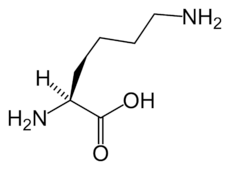Hyperlysinemia
| Hyperlysinemia | |
|---|---|
 | |
| Classification and external resources | |
| ICD-10 | E72.3 |
| ICD-9 | 270.7 |
| OMIM | 238700 |
| DiseasesDB | 33215 |
| MeSH | D020167 |
Hyperlysinemia is an autosomal recessive[1] metabolic disorder characterized by an abnormal increase of lysine in the blood, but appears to be benign.[2] It is caused by mutations in AASS, which encodes α-aminoadipic semialdehyde synthase.[1][3]

Hyperlysinemia has an autosomal recessive pattern of inheritance.
Genetics
Hyperlysinemia is inherited in an autosomal recessive manner.[1] This means the defective gene responsible for the disorder is located on an autosome, and two copies of the defective gene (one inherited from each parent) are required in order to be born with the disorder. The parents of an individual with an autosomal recessive disorder both carry one copy of the defective gene, but usually do not experience any signs or symptoms of the disorder.
See also
- Lysinuria
- Saccharopinuria
References
- ↑ 1.0 1.1 1.2 Sacksteder KA, Bier BJ, Morrell JC, Goodman BK, Geisbrecht BV, Cox RP, Gould SJ, Geraghty MT (June 2000). "Identification of the alpha-aminoadipic semialdehyde synthase gene, which is defective in familial hyperlysinemia". American Journal of Human Genetics 66 (6): 1736–1743. doi:10.1086/302919. PMC 1378037. PMID 10775527.
- ↑ Dancis, J; Hutzler J; Ampola MG; Shih VE; van Gelderen HH; Kirby LT; Woody NC (May 1983). "The prognosis of hyperlysinemia: an interim report". Am J Hum Genet. 35 (3): 438–442. PMC 1685659. PMID 6407303.
- ↑ Houten, Sander; te Brinke H, Denis S, Ruiter JP, Knegt AC, de Klerk JB, Augoustides-Savvopoulou P, Häberle J, Baumgartner MR, Coşkun T, Zschocke J, Sass JO, Poll-The BT, Wanders RJ, Duran M (Apr 9, 2013). "Genetic basis of hyperlysinemia". Orphanet J Rare Dis. 8: 57. doi:10.1186/1750-1172-8-57. PMC 3626681. PMID 23570448.
| ||||||||||||||||||||||||||||||||||||||||||||||||||||||||||||||||||||||||||||||||||||||||||||||||||||||||||||